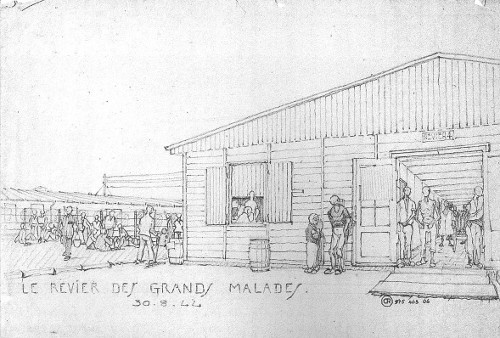The Treatment of Sick and Weak Prisoners
Physical exhaustion led to many diseases among the prisoners, but it was very difficult for sick prisoners to obtain treatment at the sick-bay. There were not enough beds or medication to treat eventhose prisoners who were gravely ill or severly wounded. Licensed doctors among the prisoners were not allowed to work at the sick-bay until late 1941. In 1942/43, prisoners who were ill for a prolonged period of time faced the threat of death by lethal injection. Weakened prisoners from Neuengamme's satellite camps were sometimes transferred back to the main camp when they were no longer fit to work. These prisoners were housed in so-called “convalescence blocks”, where conditions were dreadful and the mortality rate was exceptionally high.

Pencil Drawing by Félix Lazare Bertrand entitled “Lerevier des grands malades” (“The Sick-Bay for theSeriously Ill”) and dated “30.8.44”. The titlerefers to sick-bay 4. View through the open door with some patients in the hallway and two more outside the hut.
The Treatment of Weakened Prisoners
The living and working conditions severely weakened a large number of the prisoners. Sick prisoners who did not recover were singled out and transferred to other camps or were killed with lethal injections. The majority of the “Muselmänner” – the camp term for prisoners who were so emaciated they could no longer work –died of hunger, exhaustion and untreated diseases. From the autumn of 1944 on, Neuengamme main camp gradually became more of a reception camp for the rising number of dying prisoners who were transferred back from satellite camps. Prisoners who were seriously ill, dying or already dead were left lying crammed together in so-called “convalescence blocks” without any treatment, often three or more to one bunk.
The Treatment of Sick Prisoners and Medical Experiments
Most prisoners suffered from gastrointestinal diseases, and many had famine oedemas, tuberculosis, and inflamed wounds or had been maimed. In early 1942, the camp had to be putunder quarantine because of a typhus epidemic. A prisoner’s status in the camp determined how he was treated at the sick-bay. Most prisoners received no medical aid to speak of, and the SS turned away many needy prisoners at the sick-bay. Medicine was scarce, and wounds were dressed with crepe paper. Several patients often had to share one bed. Prisoners who suffered from contagious diseases were not sufficiently isolated. Prisoners who were licensed doctors were not allowed to work at the sick-bay until late 1941. SS doctors carried out medical experiments on prisoners at the sick-bay, infecting them with tuberculosis among other things. Sometimes, however, prisoners working as orderlies were able to protect other, severely harassed, prisoners by admitting them to the sick-bay.